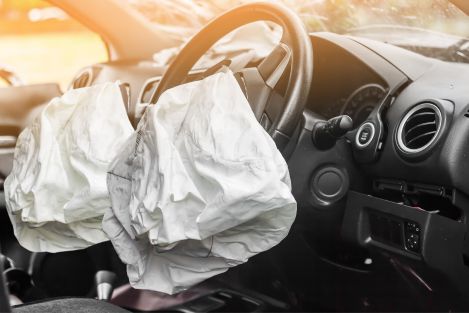
Written by Kayla Jane Barrie Updated on Mar 10, 2025 6 mins read

Single car accidents involve only one vehicle and can occur for reasons such as losing control of the car, swerving to avoid an obstacle, or encountering hazardous road conditions. Unlike multi-vehicle collisions, where responsibility is shared, these accidents typically place full responsibility on the driver involved.
According to the National Safety Council, single-vehicle crashes involving collisions with fixed objects, pedestrians, and non-collisions accounted for a greater proportion of fatalities and fatal crashes compared to less serious crashes. These types of crashes made up 54% of deaths and 56% of fatal crashes but only 25% or less of injuries.
In this blog, we explore this type of at-fault accident, how it might happen, and if it will impact your coverage.
A single car accident is a type of road traffic accident involving only one vehicle. However, they can also include pedestrians, cyclists, or wildlife. These accidents can result from run-off-road collisions, fallen debris, or collisions with deer or other animals.
They may also be due to driver-related factors such as sleep deprivation or brake failure. Unlike multi-vehicle collisions, where responsibility is shared among multiple drivers, single car accidents typically place full responsibility on the driver involved.
Imagine driving home late at night after a long day at work. It's raining heavily, and visibility is poor. Suddenly, you see a deer dart across the road. Instinctively, you swerve to avoid hitting the animal, but in doing so, your car skids off the road and hits a tree. Fortunately, you're not injured, but your car is significantly damaged. This is an example of a single car accident.
Single car accidents can happen due to various factors. Some common causes include:
Determining fault in a single car collision depends on the circumstances of the crash.
If the driver loses control due to speeding, reckless driving, or negligence, they may be at fault.
However, road conditions, weather, mechanical failures, or unexpected obstacles can also play a role. For example, if a driver loses control due to a sudden, unavoidable vehicle defect, it might be considered an accident rather than the driver’s fault. Insurance companies and law enforcement often investigate to determine fault based on the specific details of the incident.
If you're in a single-vehicle accident, you might wonder how it will affect your car insurance rates. In a single-vehicle collision, your rates can be impacted, as the driver (you) is usually found to be at fault. At-fault accidents can have a significant impact on your insurance and remain on your driving record for several years, continuing to affect your premium until the accident is removed from your record.
It's important to note that coverage for a single car accident is not guaranteed. The specific details of the accident and the types of coverage outlined in your Ontario car insurance will determine whether you are covered.
If your policy includes features like collision coverage, comprehensive coverage, and accident forgiveness, you will likely be covered for the accident.
These coverages can protect you even if you are at fault in a single-vehicle collision. For example, collision can pay for vehicle repairs regardless of fault, whether the accident involved another driver, an animal, or an object. Collision coverage can assist in replacing your car if it's totalled in the accident. If you lease or finance your vehicle, you might already have this coverage, often compulsory in most lease agreements.
Accident forgiveness can be added to your policy to safeguard your record and prevent your premium from escalating after an at-fault accident. If this is your first accident, this coverage might apply.
Leaving the scene of a single car accident can result in serious legal consequences, such as being charged with hit-and-run, a criminal offence in many jurisdictions.
It’s best to remain at the scene, exchange information with others involved, and report the accident to the authorities and your insurance provider.
If weather is the main cause of a single car accident, it can affect fault determination and how the situation is handled in several ways. Most policies cover accidents caused by adverse weather conditions, but the specifics vary. If weather is the sole cause of the accident, it is usually considered unavoidable.
However, if you drove too fast for the conditions or failed to exercise reasonable caution, you could still be partially at fault. While weather conditions can influence the outcome, drivers are still expected to drive safely and adjust to road conditions.
After a single-vehicle accident, it's important to stay calm and take specific steps to ensure your safety and properly handle the situation. Here's what you should do:
Single-vehicle accidents contribute to a significant portion of road fatalities and injuries. While unpredictable, drivers can take proactive measures to minimize their risk. Here are four crucial tips to help you avoid single-vehicle accidents:
To benefit from coverage, you must report a single car collision to your insurance company. Most policies require reporting accidents within a specific time frame, regardless of fault. Local authorities may also need to be informed about significant damages or injuries. Failing to report could lead to penalties or increased premiums.
A single car collision, like many accidents, can stay on your record for up to six years.
Single car accidents can be stressful and costly. Understanding their impact on your insurance and taking the proper steps can make the situation more manageable. Ensure safety, document the scene, and promptly report the accident to your insurer to confidently navigate the aftermath.
| Categories | Auto |
|---|---|
| Tags | AccidentsAuto Claims |
Read our insurance blog to get helpful tips, information and news.
Ontario municipalities have until November 14 to remove all automated speed enforcement cameras following fast-tracked provincial legislation. This post breaks down why the government is removing them, the pushback from road safety advocates, and what alternative measures will replace them.
What is specified perils insurance coverage? Learn about named perils policies for Ontario drivers. Get info about coverage, if you need it & answers to common questions.
What is all perils insurance? We’ll answer your questions about all perils insurance in Ontario. Learn about what it covers and if you need it.
Are you aware of how speeding tickets affect your car insurance? Here, we outline how speeding tickets can impact your policy.